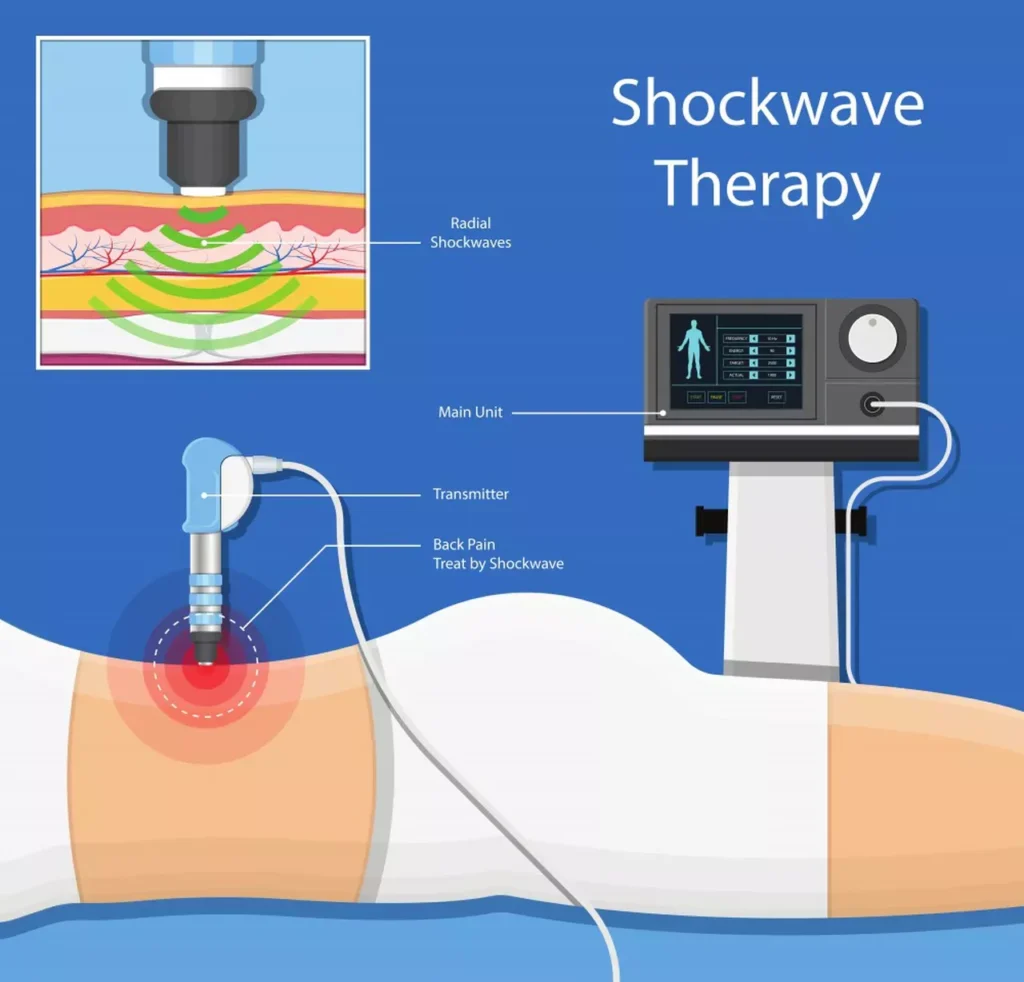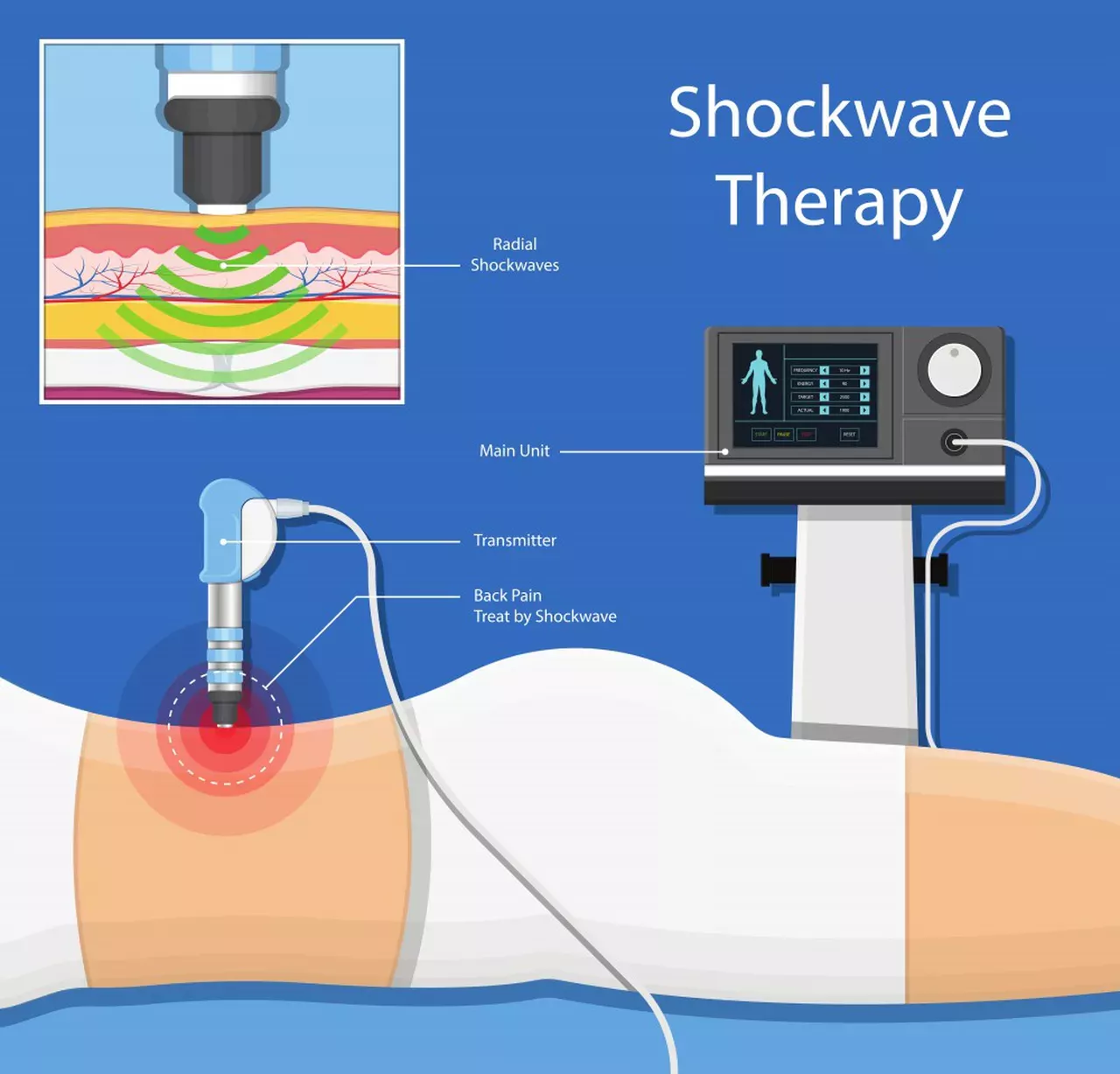
Got an injury? Don’t like needles? Shockwave Therapy might be part of the answer.
I’m always looking for evidence-based therapies that can help my patients (and me) live full, healthy lives.
For me, the best treatment options are safe, affordable, and backed by research. They also harness the innate healing ability of the human body.
Extracorporeal Shockwave Therapy (ECSWT) ticks all these boxes and more.
It’s effective in reducing pain, healing chronic and acute injuries, increasing range of motion, increasing blood flow, releasing growth factors, and improving performance. It’s basically a non-invasive, regenerative treatment. Read on to learn more.
What it can treat, what it is, and how it works.
What does Extracorporeal Shockwave Therapy (ECSWT) Help?
ECSWT has been shown to help various conditions, including treatment for soft tissue damage and chronic or acute pain within joints, ligaments, tendons, and muscles.
It’s also effective in treating and breaking scar tissue, which may increase the range of motion to levels not experienced prior to the injury.
Some examples of injuries that have published treatment efficacy with ECSWT are tennis or golfers elbow, hip pain, achilles pain, plantar fasciitis, knee pain, back pain, shoulder and rotator cuff pain, patella-femoral syndrome, ITB syndrome, muscle spasms, Duputren’s contracture, thumb arthritis.
How long does Extracorporeal Shockwave Therapy (ECSWT) take to work?
It depends on the injury. Typically, more treatments are required for chronic injuries. Sometimes 1 treatment can make a difference. Other times, we recommend weekly treatments for up to 12 weeks. The treatment itself often only takes 5 minutes.
How does Extracorporeal Shockwave Therapy (ECSWT) help heal injuries?
ECSWT improves blood flow and lymphatic drainage. It also softens scar tissue and reduces muscle spasms. It improves cell regeneration.
The benefits of the therapy’s mechanical stimulation include increased local blood flow, the breakdown of calcific deposits and adhesions, and relaxation of connective tissue. It also increased the release of substance P, prostaglandin E2, NO, TGF β, VEGF, and almost certainly other inflammatory cytokines. These signaling molecules alert the body to send resources to the area where they are released to help restore balance to the tissues.
Learn more from this policy paper published by BlueCross BlueShield of North Carolina.
What is Extracorporeal Shockwave Therapy (ECSWT), and is it FDA-Approved?
ECSWT, also known as Low-Intensity Shockwave Therapy (LiSWT) or orthotripsy, has been used for the treatment of renal stones and biliary stones since the early 1980s in Europe.
There are two types of ECSWT, focused and radial.
Focused ECSWT sends medium to high energy shockwaves of angle pressure pulses lasting microseconds, directed on a specific target using ultrasound or radiographic guidance. It was first FDA-approved in 2002.
Radial ECSWT (RSW) transmits low to medium-energy shockwaves radially over larger surface areas. It was approved by the FDA in 2007.
ECSWT is a non-invasive treatment that involves the delivery of shockwaves, essentially a pressure disturbance that propagates rapidly through a medium, to injured soft tissue.
The shock wave travels through the body until it hits something, such as scar tissue, that is dense enough to release the energy contained. This creates compression and shear loads which serve to break apart the tissue.
This ultimately reduces pain, increases range of motion, increases blood flow, releases growth factors, and promotes healing.
How does Extracorporeal Shockwave Therapy (ECSWT) work?
Boost uses the Z Wave by Zimmer, a German device that transmits powerful sound waves into the tissue. The energy then spreads out radially to enhance the treatment effect.
The body responds to the Z Wave sound waves with increased metabolic activity in the form of lymphatic drainage and increased blood circulation.
Zimmer’s electromagnetic technology uses a projectile with a five times greater mass than pneumatic systems. (Most radial shockwave systems are pneumatic systems.)
This makes for equal force using 5x less acceleration. Less acceleration means a softer, more comfortable pulse on the skin’s surface. Zimmer calls this Soft Shot Technology.
The technology accelerates a projectile in the handpiece, generating a mechanical pressure wave. This wave is transferred to the human body by an applicator head radiating in the tissue.
The tissue and decreases absorb the mechanical energy as the distance from the application site increases.
The mechanical stress causes cavitation, resulting in reactions in the tissue, breaking up adhesions, releasing growth factors, and promoting quicker healing.
Bonus Benefit of Shockwave Therapy
We generally focus more on balancing the body and improving function at Boost. But what we do on the inside often impacts our appearance on the outside. When applied, the body responds to the soundwaves with increased metabolic activity in the form of lymphatic drainage and increased blood circulation, with the end result being a decrease in the appearance of cellulite.

